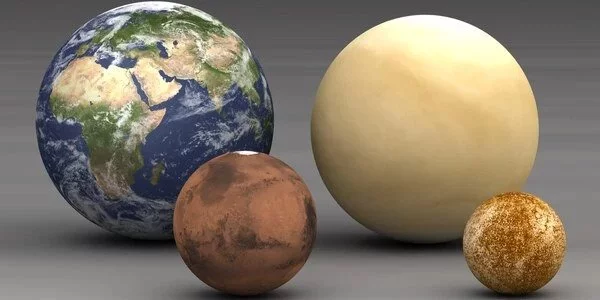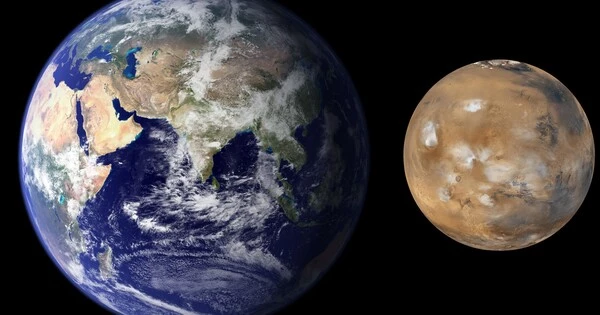Cosmochemists have now presented the most comprehensive comparison of the isotopic compositions of Earth, Mars, and pristine building material from the inner and outer Solar Systems to date.
Earth and Mars were formed primarily from material that originated in the inner Solar System; only a small percentage of the building blocks for these two planets originated beyond Jupiter’s orbit. The findings were published today in the journal Science Advances by a group of researchers led by the University of Münster (Germany). They present the most comprehensive comparison of the isotopic compositions of Earth, Mars, and pristine building material from the inner and outer Solar Systems to date. Some of this material can still be found in meteorites today, mostly undamaged.
The study’s findings have far-reaching implications for our understanding of the processes that formed the planets Mercury, Venus, Earth, and Mars. The theory that the four rocky planets grew to their current sizes by collecting millimeter-sized dust pebbles from the outer Solar System is untenable.
A disk of dust and gases orbited the young Sun approximately 4.6 billion years ago in the early days of our Solar System. Two theories explain how the inner rocky planets formed over millions of years from this original building material. The dust in the inner Solar System agglomerated to ever larger chunks, eventually reaching the size of our Moon, according to the older theory. Collisions of these planetary embryos finally produced the inner planets Mercury, Venus, Earth, and Mars.
The isotopic composition of this third type of building material, as inferred by our computer simulations, implies it must have originated in the innermost region of the Solar System. Because bodies from such close proximity to the Sun were almost never scattered into the asteroid belt, this material was almost completely absorbed into the inner planets and thus does not occur in meteorites.
Christoph Burkhardt
A newer theory, however, prefers a different growth process: millimeter-sized dust “pebbles” migrated from the outer Solar System towards the Sun. On their way, they were accreted onto the planetary embryos of the inner Solar System, and step by step enlarged them to their present size.
Meteorites as a reference
Scientists assume that in the early Solar System these and other metal isotopes were not evenly distributed. Rather, their abundance depended on the distance from the Sun. They therefore hold valuable information about where in the early Solar System a certain body’s building blocks originated.
The researchers used two types of meteorites to reference the original isotopic inventory of the outer and inner Solar Systems. These chunks of rock generally made their way to Earth from the asteroid belt, which is located between the orbits of Mars and Jupiter. They are thought to be mostly pristine material from the Solar System’s early days. While so-called carbonaceous chondrites, which can contain up to a few percent carbon, formed beyond Jupiter’s orbit and were only later relocated to the asteroid belt due to the influence of the growing gas giants, their more carbon-depleted cousins, the non-carbonaceous chondrites, are true children of the inner Solar System.

The precise isotopic composition of Earth’s accessible outer rock layers and that of both types of meteorites have been studied for some time; however, there have been no comparably comprehensive analyses of Martian rocks. In their current study, the researchers now examined samples from a total of 17 Martian meteorites, which can be assigned to six typical types of Martian rock. In addition, the scientists for the first time investigated the abundances of three different metal isotopes.
The samples of Martian meteorites were first powdered and subjected to complex chemical pretreatment. Using a multicollector plasma mass spectrometer at the Institute of Planetology at the University of Münster, the researchers were then able to detect tiny amounts of titanium, zirconium, and molybdenum isotopes.
They then used computer simulations to calculate the ratio of building material found today in carbonaceous and non-carbonaceous chondrites that must have been incorporated into Earth and Mars in order to reproduce their measured compositions. In doing so, they considered two different phases of accretion to account for the different histories of titanium, zirconium, and molybdenum isotopes, respectively. Unlike titanium and zirconium, molybdenum is primarily found in the metallic planetary core. The trace amounts still found in the silicate-rich outer layers today can thus only have been added during the planet’s final stages of formation.
Lost building material
However, the composition of Earth and Mars does not exactly match the material of non-carbonaceous chondrites. According to the computer simulations, another type of building material must have been used. “The isotopic composition of this third type of building material, as inferred by our computer simulations, implies it must have originated in the innermost region of the Solar System,” explains Christoph Burkhardt. Because bodies from such close proximity to the Sun were almost never scattered into the asteroid belt, this material was almost completely absorbed into the inner planets and thus does not occur in meteorites. “It is, in a sense, ‘lost building material,’ to which we no longer have direct access today,” says Thorsten Kleine.
The unexpected discovery has no bearing on the study’s implications for planet formation theory. “The fact that Earth and Mars appear to be primarily composed of material from the inner Solar System fits well with planet formation from collisions of large bodies in the inner Solar System,” Christoph Burkhardt concludes.
















